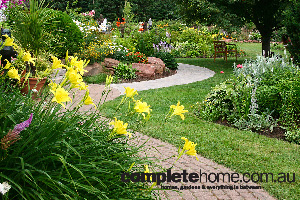Enjoy all that this season has to offer — spring is all about smelling the roses
Spring is one of the busiest and most rewarding seasons in the home garden, with many of the spring-flowering bulbs planted back in autumn beginning to reward gardeners for their time, effort and forward thinking. At the end of their winter hibernation, blooms of anemone, bluebell, daffodil, iris and tulip have already appeared or are about to blossom throughout garden beds in most parts of the country.
However, bulbs are not the only blooms bursting into action at this time of year. There are plenty of other coloured flowers that can make an impact on your spring garden — annuals, perennials and even trees and shrubs will want to get in on the act and because of their variety and colour range there’s sure to be something for everyone to enjoy.
If you are looking for instant colour, buying flowering plants in bloom will give instant gratification and ensure you get exactly the colour you are looking for.
Daisies are an extremely popular choice for a big splash for not too much cash and they are easy to grow, come in many colours and will usually self-seed the following year. They do well in warm weather and continue to flower for many months, making them a great choice as spring turns to summer.
Different varieties include paper daisies, so named because the blooms actually feel like paper; Shasta daisies, with their striking white flowers; and Livingstone daisies, which make great groundcover. Erigeron, or seaside daisies, make a great low border and still produce a small amount of flowers even during the cooler months.
Spring is a great time if you love the look of a wonderful cottage garden, as many of the ageless plants used to achieve this timeless English “chocolate box” image are out in flower. Fragrant perennials, such as lavender with its long-stemmed purple flowers swaying in the breeze and sweet peas growing up a trellis, fill the garden with scent.
Tall-growing cottage favourites, including foxgloves, delphiniums, lupins, columbines and poppies, add height to the garden while gauras and wallflowers bloom for long periods of time. Or you could grow more unusual plantings such as bells of Ireland with their tall, apple-green flower spikes or large gazanias with their striking red, black and yellow flowers. Red valerian also works well for adding a vibrant burst of colour to the garden.
There are also shrubs that can add colour to your spring garden including azaleas and rhododendrons; spiraea; the fragrant mock orange; weigela; ceanothus, which has striking blue blossoms; lilacs and, in warmer climates, bougainvillea. Fast-growing buddleia bushes have large flowers in an array of colours, are incredibly attractive to butterflies, make good hedges when mass planted and look just as good on their own.
As well as adding spring colour, shrubs will help give structure to your garden and make a nice green backdrop after their flowers fade.
For added height or shade in the garden, there are even some flowering trees that will add colour. The most obvious are the spring blossoms such as flowering cherries and plums but others include the jacaranda, dogwood, oleander and frangipani. The major advantage to such trees is that once they have finished flowering they usually put on plenty of lush green foliage to give shade to the garden during the approaching hot summer days.
There are also what I would call the showstoppers of the spring garden: largeflowering blooms such as roses and peonies. And as stubborn and cantankerous as the peony can be, if you are successful in growing them they no doubt give “wow” factor to the garden when in bloom. They do require large amounts of lime and some very specific conditions, but they are well worth all the effort with their blooms making great cut flower arrangements, too.
As for the ever-popular rose, there are a multitude of spring-flowering varieties amongst the Hybrid teas, the climbers and the old-fashioned varieties. You can really choose any colour you like in both highly fragrant and lightly fragrant varieties.
Roses come in a variety of growing types, from climbers that will cover arbours and walls to shrubs, groundcovers and smaller patio-sized versions that do well in a pot. You could also grow them as standards whereby you remove any sidegrowing shoots and allow the main stem to grow straight up with the foliage on top so the rose forms a topiary shape.




